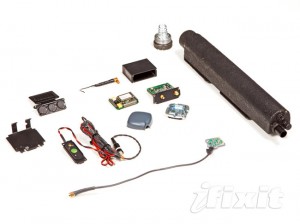FBI Tracking Device Breakdown
There’s been a lot of controversy surrounding the FBI’s use of vehicle tracking devices without obtaining warrants, and the latest news is that a 9th Circuit Court judge seems to think that this is an okay way to do things. It’s hardly likely that the last word is said in the matter, but that’s where it stands as of writing this, at least.

iFixit got their hands on one of the devices that the FBI uses to track vehicles – we say “one of”, because there’s almost sure to be several types of tracking devices in use – and broke it down into its components. The device is called “Orion Guardian ST820”, and costs a whopping $6000!
What was revealed was a long-lived but fairly outdated device (main components launched in 1999) that will indeed track a car by sending GPS coordinates via RF to a receiver unit. The PCB (printed circuit board) has been modified by the FBI to suit their needs, and the whole party is powered by a number of D-cell batteries, each with a capacity of 13,000 mAh (which is actually pretty impressive).
The device is made up of two main parts; the battery pack, and the electronics. Anyone interested in taking a peek at the device should visit iFixit – it’s worth a look.
Right here’s a view of the device when it’s assembled ready to do business. According to an unnamed “former agent” of the FBI, the device is old, and newer devices are placed in the car’s engine bay, hard wired to the battery so it won’t be drained and rendered useless if the car is put away, ends up in a body shop or repair shop for some reason. Just another reason to check below the hood every once in a while…
GPS tracking is a good way of keeping an eye (in the sky…) on your own car, as our previous post talked about, but it’s important to remember that the method isn’t yours exclusively – it can also be used to keep tabs on you.
